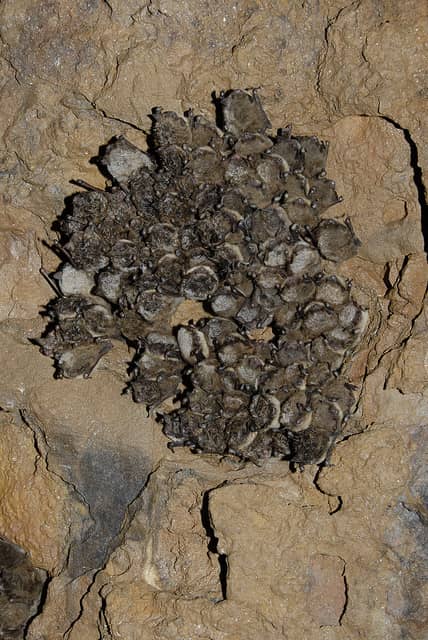Statewide Survey Detects No Evidence of White Nose Syndrome in Michigan Bats
OutdoorHub 04.26.12

For now, Michigan bats are safe from the widespread fungal disease that has been the worst bat killer of the decade in North America. White nose syndrome (WNS) has already taken the lives of an estimated 5 million to 7 million bats since it was first discovered in New York in 2006. Almost routinely, other states have confirmed initial cases of WNS; Alabama had its first confirmed case just in March of this year and Ohio followed suit not long afterward. More states continue to monitor and take precautions against the syndrome that has a roughly 95 percent mortality rate among bats.
Original press release issued by Michigan Department of Natural Resources on April 26, 2012:
A recent statewide survey of 60 bat wintering sites in Michigan found no sign of white nose syndrome, the Department of Natural Resources said today.
White nose syndrome (WNS) is an invasive fungus fatal to bats. The fungus infects a bat’s skin and causes the bat’s energy reserves to deplete before the hibernation period is over.
The survey – conducted by DNR Wildlife Division staff in conjunction with Dr. Allen Kurta and Steve Smith of Eastern Michigan University – involved extensive surveillance of caves and abandoned mines across the northern Lower Peninsula and Upper Peninsula. These survey locations represent the major bat colony hibernation sites in Michigan, with some colonies numbering over 50,000 bats.
“Our survey efforts focused on areas where WNS would most likely first appear,” said DNR Wildlife Biologist Bill Scullon. “Given the speed with which this devastating disease has spread across the country, we’re very pleased to have found no visible signs of WNS in Michigan this season. Unfortunately, all indications are that the disease will eventually arrive here.”
The invasive fungus Geomyces destructans (Gd) that causes WNS is believed to have originated in Europe and has spread to 19 states and four Canadian provinces since the first outbreak site was discovered in eastern New York in 2006. WNS has been confirmed in Ontario, less than 90 miles from the Michigan border, as well as in Ohio and Indiana.
The US Fish & Wildlife Service estimates that since WNS was first detected in the United States, more than 5.5 million bats from six different species have died from the disease, with the mortality rate nearing 95 percent in some affected sites.
Nine species of bats can be found in Michigan, with cave-dwelling bats, such as little brown bats, big brown bats, tri-colored bats, northern long-eared bats, and the federally-endangered Indiana bats, at the greatest risk of contracting WNS.
“These species all gather in large concentrations in caves and abandoned mines to hibernate during the winter months,” Scullon said. “Unfortunately, the cold temperatures which normally would help the bats conserve body fat during hibernation may now be part of their undoing, because the fungus that causes WNS grows optimally in these cold conditions.”
Further contributing to the rapid spread of WNS through many Eastern and Midwestern states, the WNS fungus persists in the environment even without a host and can be carried from one location to another by humans, Scullon said, adding that no known human health risks are associated with Gd, nor are any other wildlife species known to be impacted by the fungus.
Michigan’s bat species are insectivores and are a highly-beneficial as a natural insect control mechanism. Bats help to protect agricultural crops and forests from damage done by insects such as corn ear worms and gypsy moths, and also reduce the threat of insect-borne diseases such as West Nile virus. The economic benefit of a healthy bat population in Michigan has been estimated at $508 million annually, and more than $23 billion nationwide.
“The DNR is cooperating with researchers, universities, state, federal and tribal agencies, landowners, and concerned citizens to delay the spread of WNS to Michigan, and to prepare for the arrival and aftermath of the disease once it is found here,” said DNR wildlife veterinarian Dr. Dan O’Brien. “Public support is critical to minimizing the spread of WNS, facilitating early detection efforts, and conserving remaining bat populations as they recover.”
Contact Bill Scullon at 906-353-6651 for more information about the recent statewide WNS survey or Michigan’s bat population. Additional information about WNS, including Michigan’s WNS Response Plan and bat observation reporting instructions, is available online at www.michigan.gov/emergingdiseases.
The Michigan Department of Natural Resources is committed to the conservation, protection, management, use and enjoyment of the state’s natural and cultural resources for current and future generations. For more information, go to www.michigan.gov/dnr.

